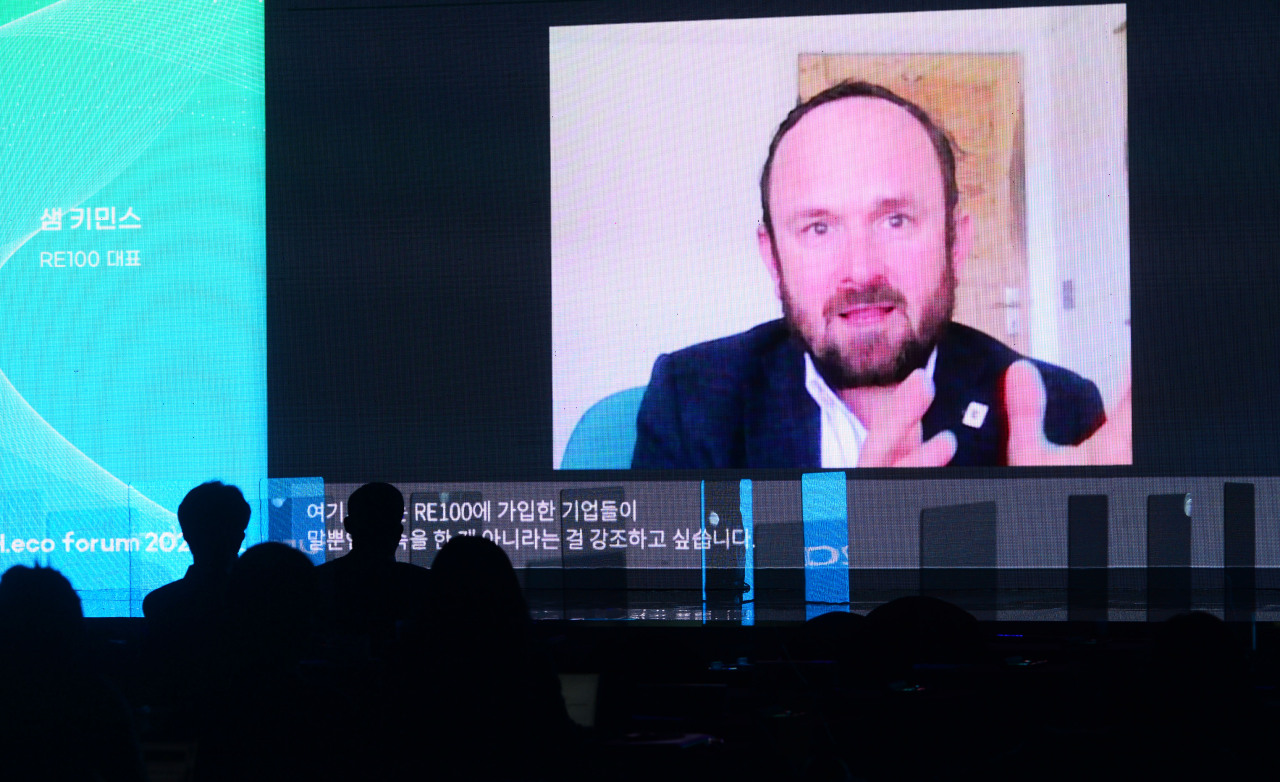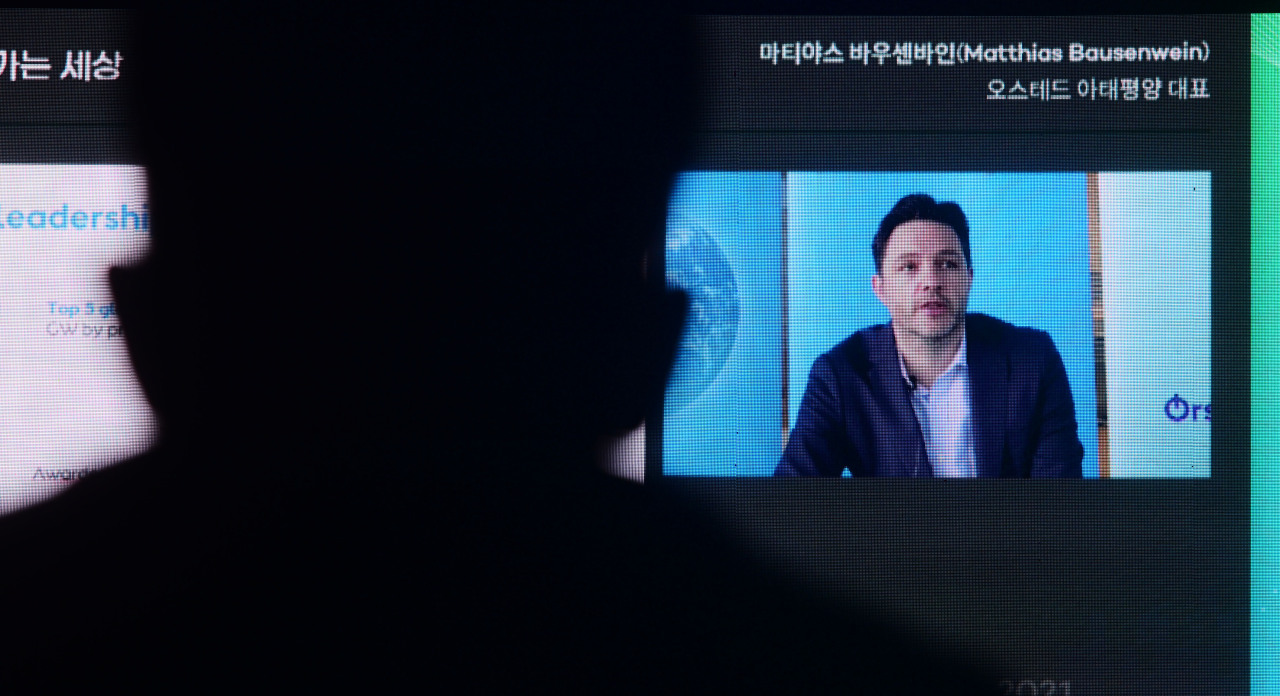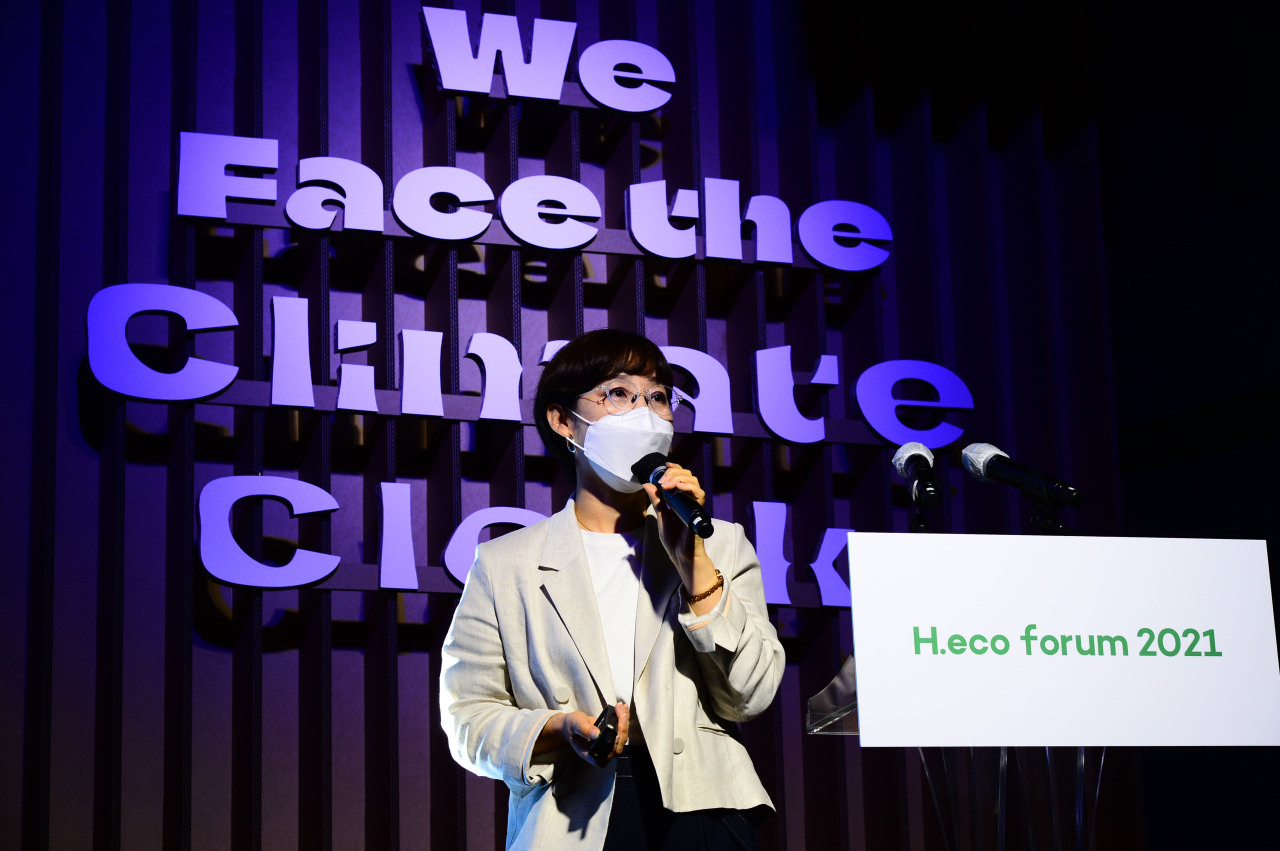[#WeFACE] RE100, Orsted, Amorepacific chiefs say green transition is a matter of will
Green is good for business, says global No. 1 offshore wind player, Korea’s beauty conglomerate
By Kim Byung-wookPublished : June 10, 2021 - 16:01

For 221 of the world’s major companies to source 100 percent of electricity from renewable sources by 2030, they’ll have to spend $98 billion.
But make no mistake. These members of Renewable Energy 100 -- a global initiative to use electricity generated exclusively from renewable energy -- are not burning their cash just for the greater good of saving the Earth.
They’re doing this for their own good, Sam Kimmins, head of the Climate Group’s RE100 campaign, said at the first H.eco Forum by Herald Corp. held on Nodeul Island in Seoul, Thursday.
“Why are companies doing this? (For) Ikea, Swiss Re and the other early joiners, it’s just the right thing to do. We need to send a signal that there is a demand for renewable electricity,” he said during the forum’s second session themed on green industrial transition.
“But these are also business-savvy businesses. These are smart businesses. They are forward-thinking companies that knew that there was business advantage in committing 100 percent to renewable electricity.”
Launched seven years ago, RE100 brings together the world’s most influential businesses to use 100 percent renewable energy. At the helm of the initiative is Kimmins, who has more than 20 years of experience leading sustainability projects in the shipping, aviation, food, construction and NGO sectors. Today, a total of 311 companies have joined RE100.
More companies are joining RE100 as the movement is getting cheaper to follow, according to Kimmins. The cost of solar power has fallen 85 percent since 2010 and that of onshore wind has dropped 49 percent in the same period.
Despite improving market conditions, Korea has fallen behind the trend, with just nine members of RE100, a stark contrast with Japan, which has 54 member companies.
Korea had better catch up, as lagging behind RE100 means losing valuable customers, Kimmins warns.
“Large corporates such as Apple, Google and others are increasingly asking their supply chains to use renewable electricity. One hundred Apple suppliers have committed to use 100 percent renewables to supply Apple goods. Google’s ambition is to have their suppliers in every region to be powered using renewable sources,” he said.
“When we surveyed our members in 2020, 20 of them had told us that they had a current active policy to ask their suppliers to use renewable electricity. Fourteen told us that they were planning to introduce such a policy. We are seeing this trend expand dramatically.”

The second session was also joined by Matthias Bausenwein, president of Orsted Asia Pacific, who said while the global green transition may be painful for conventional companies, it can open a new whole new chapter for growth.
Orsted has been ranked by Corporate Knights as the world’s most sustainable energy company for three years in a row and stands as the No. 1 global offshore wind power player. But there was a time when it faced difficulties for sticking to the oil business.
“Only a decade ago, Orsted was a fossil-fueled utility established through a merger in 2006. We were called DONG Energy, which stood for Danish oil and natural gas. Our power and heat production mix in 2006 was dominated by coal,” said Bausenwein, who has been spearheading Orsted projects in the Asia-Pacific region for many years.
“Then in 2012, we got an intense financial pressure. Operating profits went down and debt went up. It was because of rapid decline in earnings from gas and coal-fired power plants due to drop in power prices.”
Compounded by losses on long-term gas sourcing contracts, liquefied natural gas positions and gas storage, Orsted ditched eight business areas and decided to concentrate on four including offshore wind, which then became the company’s mainstay.
Since 2012, Orsted has relentlessly tried to bring down the cost of offshore wind, eventually reaching 56 euros ($68) per megawatt-hour as of last year from 167 euros. By 2030, Orsted is aiming to generate 30 gigawatts of clean energy, which would be enough to supply renewable electricity to more than 55 million people.
Korea is one of the beneficiaries of Orsted’s ambitious plan. Orsted is currently building a 1.6-gigawatt offshore wind farm 70 kilometers off the coast of Incheon. Set for commercial operation as early as 2026, the project will be able to power 1.3 million households per year. At the same time, the wind farm will reduce almost 4 million metric tons of carbon dioxide emissions, which would be equivalent to removing 1.8 million cars off the road.

The last speaker of H.eco Fourm’s second session was Oh Jeong-hwa, director of the sustainability management division of Amorepacific, the nation’s beauty and cosmetics conglomerate. During her lecture titled “A MORE beautiful promise for the planet empathy,” Oh spoke of how sustainable production and consumption can make people’s lives greener, and more beautiful.
Amorepacific has helped lead the eco-friendly movement in the beauty industry, launching the first refill station at Amore Store Gwanggyo in Gyeonggi Province. This year, Amorepacific joined RE100 as the first Korean beauty company.
On top of joining RE100, Amorepacific aims to make its packaging 100 percent reusable, recyclable and compostable.
“Amorepacific will also transport its goods 100 percent with eco-friendly vehicles by 2030,” said Oh, who leads the company’s climate strategy.
In any product lineup, raw materials account for 72 percent of a product’s carbon emissions, according to Amorepacific’s lifecycle analysis. The remaining 13 percent, 11 percent and 4 percent are generated when the product is used, manufactured and thrown away, respectively.
Based on the analysis, Amorepacific changed raw materials, redesigned containers and minimized the use of packaging. For example, Amorepacific reduced the use of water by 10.6 percent when it manufactures containers for its Laneige Water Sleeping Mask Ex skincare product. It also was able to cut 12.7 percent of greenhouse gas emissions when making containers for its Osulloc Sejak Green Tea product.
Amorepacific was also able to reduce waste by 90 percent by extracting healthy components from green tea byproducts and turning them into anti-oxidant tablets called Meta Green that facilitate better metabolism.
By Kim Byung-wook (kbw@heraldcorp.com)


















![[Today’s K-pop] Treasure to publish magazine for debut anniversary](http://res.heraldm.com/phpwas/restmb_idxmake.php?idx=642&simg=/content/image/2024/07/26/20240726050551_0.jpg&u=)